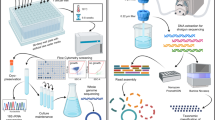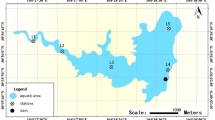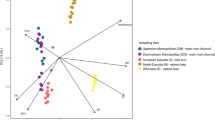Abstract
Microbial rhodopsins are membrane proteins that utilize a retinal chromophore to harvest sunlight for energetic and photosensory functions. Recently, a group of novel rhodopsin sequences named ‘actinorhodopsins’ (ActRs) was hypothesized to exist among uncultured planktonic Actinobacteria. ActRs were discovered by mining metagenomic data obtained during the Venter Institute's Global Ocean Sampling expedition, from a hypersaline lagoon, two estuaries and a freshwater lake. On the basis of these findings, and many studies that show Actinobacteria are common inhabitants of lakes, we predicted that ActR genes would likely be present in other freshwater habitats and among the genomes of cultivated Actinobacteria. Using degenerate polymerase chain reaction primers, we discovered an ActR gene present in an actinobacterial isolate of the family Microbacteriaceae. Isolate MWH-Uga1 was cultivated prior to this study from a freshwater pond in Uganda and belongs to a group of Actinobacteria previously identified in freshwater ecosystems. ActR genes were also discovered present in numerous mixed cultures containing freshwater Actinobacteria and among environmental DNA samples obtained from three freshwater sources; a small woodland pond and the Laurentian Great Lakes Superior and Erie. An analysis of small subunit ribosomal RNA genes from metagenomic DNA samples harboring ActR genes suggests that organisms belonging to the acI lineage, an uncultured group of Actinobacteria commonly present in fresh waters, may utilize rhodopsins. The co-occurrence of an acI organism with a specific ActR variant in a mixed culture supports our hypothesis.
Similar content being viewed by others
Log in or create a free account to read this content
Gain free access to this article, as well as selected content from this journal and more on nature.com
or
References
Allgaier M, Grossart HP . (2006). Diversity and seasonal dynamics of Actinobacteria populations in four lakes in northeastern Germany. Appl Environ Microbiol 72: 3489–3497.
Atamna-Ismaeel N, Sabehi G, Sharon I, Witzel KP, Labrenz M, Jürgens K et al. (2008). Widespread distribution of proteorhodopsins in freshwater and brackish ecosystems. ISME J 2: 656–662.
Beja O, Aravind L, Koonin EV, Suzuki MT, Hadd A, Nguyen LP et al. (2000). Bacterial rhodopsin: evidence for a new type of phototrophy in the sea. Science 289: 1902–1906.
Bolhuis H, Palm P, Wende A, Falb M, Rampp M, Rodriguez-Valera F et al. (2006). The genome of the square archaeon Haloquadratum walsbyi: life at the limits of water activity. BMC Genomics 7: 169.
Campbell BJ, Waidner LA, Cottrell MT, Kirchman DL . (2008). Abundant proteorhodopsin genes in the North Atlantic Ocean. Environ Microbiol 10: 99–109.
Eddy SR . (1998). Profile hidden Markov models. Bioinformatics 14: 755–763.
Fuhrman JA, Schwalbach MS, Stingl U . (2008). Proteorhodopsins: an array of physiological roles? Nat Rev Microbiol 6: 488–494.
Glockner FO, Zaichikov E, Belkova N, Denissova L, Pernthaler J, Pernthaler A et al. (2000). Comparative 16S rRNA analysis of lake bacterioplankton reveals globally distributed phylogenetic clusters including an abundant group of actinobacteria. Appl Environ Microbiol 66: 5053–5065.
Gomez-Consarnau L, Gonzalez JM, Coll-Llado M, Gourdon P, Pascher T, Neutze R et al. (2007). Light stimulates growth of proteorhodopsin-containing marine Flavobacteria. Nature 445: 210–213.
Gonzalez JM, Fernandez-Gomez B, Fernandez-Guerra A, Gomez-Consarnau L, Sanchez O, Coll-Llado M et al. (2008). Genome analysis of the proteorhodopsin-containing marine bacterium Polaribacter sp. MED152 (Flavobacteria). Proc Natl Acad Sci USA 105: 8724–8729.
Guindon S, Gascuel O . (2003). A simple, fast, and accurate algorithm to estimate large phylogenies by maximum likelihood. Syst Biol 52: 696–704.
Guindon S, Lethiec F, Duroux P, Gascuel O . (2005). PHYML Online—a web server for fast maximum likelihood-based phylogenetic inference. Nucleic Acids Res 33: W557–W559.
Hahn MW . (2009). Description of seven Candidatus species affiliated with the phylum Actinobacteria, representing planktonic freshwater bacteria. Int J Syst Evol Microbiol 59: 112–121.
Hahn MW, Lünsdorf H, Wu Q, Schauer M, Höfle MG, Boenigk J et al. (2003). Isolation of novel ultramicrobacteria classified as Actinobacteria from five freshwater habitats in Europe and Asia. Appl Environ Microbiol 69: 1442–1451.
Hahn MW, Pöckl M . (2005). Ecotypes of planktonic Actinobacteria with identical 16S rRNA genes adapted to thermal niches in temperate, subtropical, and tropical freshwater habitats. Appl Environ Microbiol 71: 766–773.
Hahn MW, Stadler P, Wu QL, Pöckl M . (2004). The filtration-acclimatization method for isolation of an important fraction of the not readily cultivable bacteria. J Microbiol Methods 57: 379–390.
Hassler CS, Havens SM, Bullerjahn GS, McKay RML, Twiss MR . (2009). Iron speciation in western Lake Superior measured using combined physical, chemical and biological assessment. Limnol Oceanogr (in press).
Ivanikova NV, Popels LC, McKay RM, Bullerjahn GS . (2007). Lake Superior supports novel clusters of cyanobacterial picoplankton. Appl Environ Microbiol 73: 4055–4065.
Jensen PR, Lauro FM . (2008). An assessment of actinobacterial diversity in the marine environment. Antonie Van Leeuwenhoek 94: 51–62.
Jezbera J, Sharma AK, Brandt U, Doolittle WF, Hahn MW . (2009). ‘Candidatus Planktophila limnetica’, an Actinobacterium representing one of the most numerically important taxa in freshwater bacterioplankton. Int J Syst Evol Microbiol (in press).
Katz LA, Curtis EA, Pfunder M, Landweber LF . (2000). Characterization of novel sequences from distantly related taxa by walking PCR. Mol Phylogenet Evol 14: 318–321.
Ludwig W, Strunk O, Westram R, Richter L, Meier H, Yadhukumar et al (2004). ARB: a software environment for sequence data. Nucleic Acids Res 32: 1363–1371.
Martinez A, Bradley AS, Waldbauer JR, Summons RE, DeLong EF . (2007). Proteorhodopsin photosystem gene expression enables photophosphorylation in a heterologous host. Proc Natl Acad Sci USA 104: 5590–5595.
Newton RJ, Jones SE, Helmus MR, McMahon KD . (2007). Phylogenetic ecology of the freshwater Actinobacteria acI lineage. Appl Environ Microbiol 73: 7169–7176.
Rusch DB, Halpern AL, Sutton G, Heidelberg KB, Williamson S, Yooseph S et al. (2007). The Sorcerer II Global Ocean Sampling Expedition: Northwest Atlantic through Eastern Tropical Pacific. PLoS Biol 5: e77.
Sabehi G, Loy A, Jung KH, Partha R, Spudich JL, Isaacson T et al. (2005). New insights into metabolic properties of marine bacteria encoding proteorhodopsins. PLoS Biol 3: e273.
Seshadri R, Kravitz SA, Smarr L, Gilna P, Frazier M . (2007). CAMERA: a community resource for metagenomics. PLoS Biol 5: e75.
Sharma AK, Zhaxybayeva O, Papke RT, Doolittle WF . (2008). Actinorhodopsins: proteorhodopsin-like gene sequences found predominantly in non-marine environments. Environ Microbiol 10: 1039–1056.
Tamura K, Dudley J, Nei M, Kumar S . (2007). MEGA4: Molecular Evolutionary Genetics Analysis (MEGA) software version 4.0. Mol Biol Evol 24: 1596–1599.
Trutko SM, Dorofeeva LV, Evtushenko LI, Ostrovskii DN, Hintz M, Wiesner J et al. (2005). [Isoprenoid pigments in representatives of the family Microbacteriaceae]. Mikrobiologiia 74: 335–341.
Ventura M, Canchaya C, Tauch A, Chandra G, Fitzgerald GF, Chater KF et al. (2007). Genomics of Actinobacteria: tracing the evolutionary history of an ancient phylum. Microbiol Mol Biol Rev 71: 495–548.
Warnecke F, Amann R, Pernthaler J . (2004). Actinobacterial 16S rRNA genes from freshwater habitats cluster in four distinct lineages. Environ Microbiol 6: 242–253.
Warnecke F, Sommaruga R, Sekar R, Hofer JS, Pernthaler J . (2005). Abundances, identity, and growth state of actinobacteria in mountain lakes of different UV transparency. Appl Environ Microbiol 71: 5551–5559.
Whelan S, Goldman N . (2001). A general empirical model of protein evolution derived from multiple protein families using a maximum-likelihood approach. Mol Biol Evol 18: 691–699.
Wilhelm SW, Bullerjahn GS, Rinta-Kanto JM, Eldridge ML, Bourbonniere RA . (2006). Seasonal hypoxia and the genetic diversity of prokaryote populations in the central basin hypolimnion of Lake Erie: evidence for abundant picocyanobacteria and photosynthesis. J Great Lakes Res 32: 657–671.
Yang Z . (1993). Maximum-likelihood estimation of phylogeny from DNA sequences when substitution rates differ over sites. Mol Biol Evol 10: 1396–1401.
Acknowledgements
We thank Paul Jensen and Federico Lauro for providing their actinobacterial SSU rRNA sequence database for GOS samples. AKS and WFD are grateful to the Nova Scotia Health Research Foundation and the Canadian Institute for Health Research for funding support. Additional funding was provided by National Science Foundation award OCE-0352274 to GSB. We also thank the captains and crews of the R/V Blue Heron and CCGS Limnos for assistance in collecting samples from the Great Lakes. We acknowledge that some sequence data used in this study were obtained during the Global Ocean Sampling expedition from the waters of Canada, Mexico, Honduras, Costa Rica, Panama, Ecuador and French Polynesia/France. All sequencing data collected from the waters of the above-named countries remain part of the genetic patrimony of the country from which they were obtained.
Author information
Authors and Affiliations
Corresponding author
Additional information
Supplementary Information accompanies the paper on The ISME Journal website (http://www.nature.com/ismej)
Rights and permissions
About this article
Cite this article
Sharma, A., Sommerfeld, K., Bullerjahn, G. et al. Actinorhodopsin genes discovered in diverse freshwater habitats and among cultivated freshwater Actinobacteria. ISME J 3, 726–737 (2009). https://doi.org/10.1038/ismej.2009.13
Received:
Revised:
Accepted:
Published:
Issue date:
DOI: https://doi.org/10.1038/ismej.2009.13
Keywords
This article is cited by
-
Ion-pumping microbial rhodopsin protein classification by machine learning approach
BMC Bioinformatics (2023)
-
Photoheterotrophy by aerobic anoxygenic bacteria modulates carbon fluxes in a freshwater lake
The ISME Journal (2022)
-
Temporal and spatial differences of the under-ice microbiome are linked to light transparency and chlorophyll-a
Hydrobiologia (2022)
-
Culturing the ubiquitous freshwater actinobacterial acI lineage by supplying a biochemical ‘helper’ catalase
The ISME Journal (2019)
-
A distinct abundant group of microbial rhodopsins discovered using functional metagenomics
Nature (2018)



